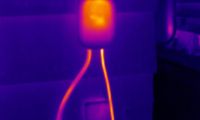When the C7 Corvette Z06 was introduced, it was immediately billed as the most track capable Corvette of all time. Considering the racing history of the Corvette, that is a serious claim and with the combination of the powerful LT4 engine and the Magnetic Ride Control suspension system, the C7 Z06 had everything needed to be a track day terror.
Or, at least the new Corvette Z06 seemed to have everything needed to dominate the track, but owners quickly found a problem. After short periods of hard driving, especially in hotter climates, the LT4 would go into a safety mode, power levels would drop and the Z06 was electronically transformed into a track failure. At first, owners thought that something was wrong with their new Corvette, but it was quickly announced that to preserve the engine internals, the LT4 had a built-in safe mode for situations when the engine was hot.
As you might imagine, owners were enraged at their inability to spend a day at the track and the “cooling troubles” became a black eye for the C7 Corvette Z06.
Fortunately, while speaking with Motor Authority, Corvette chief engineer Tadge Juechter explained that those cooling issues were addressed ahead of the 2017 model year, so Z06 models built after the 2016 model year should not be affected by those early issues. More importantly, the team made sure that the new ZR1 would not run into similar problems.
Addressing the Problem
While speaking with Motor Authority, Juechter explained that the cooling issues and safe mode problems were found to occur mostly with 2015 and 2016 Corvette Z06 models with the automatic transmission, or cars from the same model years which had been modified. He pointed out that something like stickier tires, stronger brakes or even a cold air intake could lead to more heat during track sessions and when the car was tested by GM, it was tested in stock form. As a result, those aftermarket modifications – even the very simple ones – were found to cause excess heat in the 2015-2016 Z06.
As for those unaltered cars with the automatic transmission, the 2017 models received new engine and transmission calibrations, along with a beefier cooling system.
The issue with the early Z06 was in the levels to which the car was tested. Chevrolet engineers validated the car to 30 degrees Celcius (87 degrees Fahrenheit), but they quickly found that owners were pushing them to much higher temperatures. With that in mind, the later Z06 models and the new ZR1 were validated to much higher temperatures, with the LT5 being tested up to 100 degrees Celsius or 212 degrees Fahrenheit.
Part of the ZR1’s ability to withstand these extreme temperatures is the addition of four extra heat exchanges for the engine, along with a front fascia that directs far more cool air into the engine bay and the cooling system. As a result, the Corvette ZR1 is able to run for hours on end without running into cooling issues, helping to make it one of the greatest performance cars on sale today.













Comments
I must comment on this
Permalink
I must comment on this statement - "Part of the ZR1’s ability to withstand these extreme temperatures is the addition of four extra heat exchanges for the engine, along with a front fascia that directs far more cool air into the engine bay and the cooling system. As a result, the Corvette ZR1 is able to run for hours on end without running into cooling issues, helping to make it one of the greatest performance cars on sale today."
That statement is a joke right? The 2019 ZR1 manual transmission has a serious flaw in the cooling set up of the trans oil. The manual does NOT have a fan at the inter cooler located behind the left quarter panel. The vents on top of the quarter panel force air across the inter cooler, not through it! The FACT is that the trans oil temps rise every single lap on the track and the trans oil overheats inside 20 minutes even at 70 degree ambient temps. FACT! The manual transmission ZR1 cannot handle (2) 15 minute sessions on the track with a 15 minute break, even when an external fan is used to blow through the rear vent to cool the trans oil between sessions. All FACTS. I have all the data and GM knows all about it.
Chevy has a much different
Permalink
In reply to I must comment on this by paul Speedo (not verified)
Chevy has a much different definition of “validated” than anyone else I’ve met at a track day. My car is stock 2017 manual and even in the mid 70’s the coolant at laguna Seca will get up 228 degrees and I have the lap times and temps on the PDR to prove it. I’m not even a record setting driver. The car should be under 200 at all times or it is pulling power, that’s what validated should mean. If they “validated” the car to be at 200 water at 87* ambient nobody would have an issue in 95+ it would just run at 215-225 but it’s obviously a lie. It probably got to 255* water which is 7* under their limp mode “overheating” point.